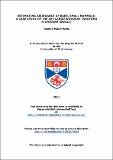Files in this item
Estimating abundance of rare, small mammals: A case study of the Key Largo woodrat (Neotoma floridana smalli)
Item metadata
| dc.contributor.advisor | Buckland, S. T. (Stephen T.) | |
| dc.contributor.advisor | Thomas, Len | |
| dc.contributor.advisor | Savage, Anne | |
| dc.contributor.author | Potts, Joanne M. | |
| dc.coverage.spatial | 222 | en_US |
| dc.date.accessioned | 2011-11-24T12:49:19Z | |
| dc.date.available | 2011-11-24T12:49:19Z | |
| dc.date.issued | 2011 | |
| dc.identifier.uri | https://hdl.handle.net/10023/2068 | |
| dc.description.abstract | Estimates of animal abundance or density are fundamental quantities in ecology and conservation, but for many species such as rare, small mammals, obtaining robust estimates is problematic. In this thesis, I combine elements of two standard abundance estimation methods, capture-recapture and distance sampling, to develop a method called trapping point transects (TPT). In TPT, a "detection function", g(r) (i.e. the probability of capturing an animal, given it is r m from a trap when the trap is set) is estimated using a subset of animals whose locations are known prior to traps being set. Generalised linear models are used to estimate the detection function, and the model can be extended to include random effects to allow for heterogeneity in capture probabilities. Standard point transect methods are modified to estimate abundance. Two abundance estimators are available. The first estimator is based on the reciprocal of the expected probability of detecting an animal, ^P, where the expectation is over r; whereas the second estimator is the expectation of the reciprocal of ^P. Performance of the TPT method under various sampling efforts and underlying true detection probabilities of individuals in the population was investigated in a simulation study. When underlying probability of detection was high (g(0) = 0:88) and between-individual variation was small, survey effort could be surprisingly low (c. 510 trap nights) to yield low bias (c. 4%) in the two estimators; but under certain situations, the second estimator can be extremely biased. Uncertainty and relative bias in population estimates increased with decreasing detectability and increasing between-individual variation. Abundance of the Key Largo woodrat (Neotoma floridana smalli), an endangered rodent with a restricted geographic range, was estimated using TPT. The TPT method compared well to other viable methods (capture-recapture and spatially-explicit capture-recapture), in terms of both field practicality and cost. The TPT method may generally be useful in estimating animal abundance in trapping studies and variants of the TPT method are presented. | en_US |
| dc.language.iso | en | en_US |
| dc.publisher | University of St Andrews | |
| dc.subject | Abundance estimation | en_US |
| dc.subject | Small mammals | en_US |
| dc.subject | Key Largo woodrat | en_US |
| dc.subject | Trapping point transects | en_US |
| dc.subject | Capture recapture | en_US |
| dc.subject | Spatially-explicit capture recapture | en_US |
| dc.subject.lcc | QL708.6P7 | |
| dc.subject.lcsh | Mammal populations--Estimates | en_US |
| dc.subject.lcsh | Rare mammals | en_US |
| dc.subject.lcsh | Wood rats--Florida--Key Largo Region | en_US |
| dc.subject.lcsh | Sampling (Statistics) | en_US |
| dc.title | Estimating abundance of rare, small mammals: A case study of the Key Largo woodrat (Neotoma floridana smalli) | en_US |
| dc.type | Thesis | en_US |
| dc.type.qualificationlevel | Doctoral | en_US |
| dc.type.qualificationname | PhD Doctor of Philosophy | en_US |
| dc.publisher.institution | The University of St Andrews | en_US |
| dc.publisher.department | Disney's Animal Kingdom | en_US |
This item appears in the following Collection(s)
Items in the St Andrews Research Repository are protected by copyright, with all rights reserved, unless otherwise indicated.

